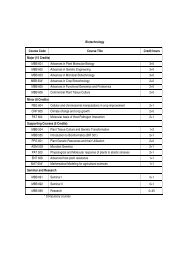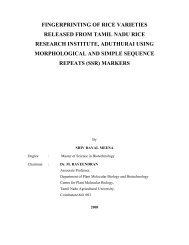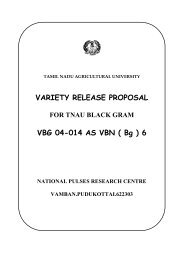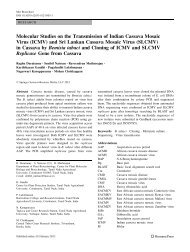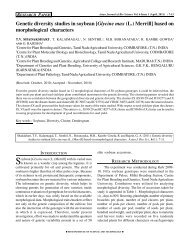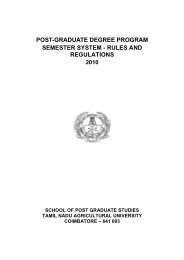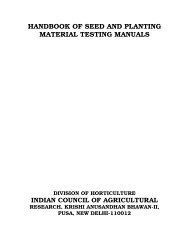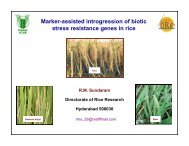T. reesei - TNAU Genomics
T. reesei - TNAU Genomics
T. reesei - TNAU Genomics
You also want an ePaper? Increase the reach of your titles
YUMPU automatically turns print PDFs into web optimized ePapers that Google loves.
Please purchase PPT to Flash on http://www.verydoc.com to remove this watermark.<br />
Protein quality control in the<br />
industrially - exploited fungal<br />
cell factory Trichoderma <strong>reesei</strong><br />
Prof Helena Nevalainen, Dr Liisa Kautto,<br />
Dr Jasmine Grinyer and Dr Junior Te’o<br />
Please purchase PPT to Flash on http://www.verydoc.com to remove this watermark.<br />
1
Please purchase PPT to Flash on http://www.verydoc.com to remove this watermark.<br />
Prof Helena Nevalainen, brief biography<br />
FUNGAL BIOTECHNOLOGIST<br />
Research interests include molecular biology and functional<br />
proteomics of biotechnologically important filamentous fungi, in<br />
particular the industrially-exploited Trichoderma <strong>reesei</strong>. T. <strong>reesei</strong> offers<br />
a powerful cell factory for efficient expression of valuable gene<br />
products for various industrial and pharmaceutical applications. Other<br />
research interests feature fungal proteomics, biological control and<br />
molecular prospecting of the environment for novel bioactivities.<br />
Brief employment history:<br />
2009- Member of the Australian Research Council College of Experts<br />
2008- Head of the Department of Chemistry and Biomolecular Sciences, Macquarie<br />
University, Sydney<br />
2005- Professor of Biotechnology (Personal Chair) Department of Chemistry and<br />
Biomolecular Sciences, MU<br />
_____________________________________________________________________<br />
1993- present Consultant to ROAL Ltd Finland<br />
1992- present Adjunct Professor (Docent) in Applied Microbial Genetics, University of<br />
Helsinki, Faculty of Science<br />
1989-1992 Head, Microbiological Department, Research Laboratories of ALKO Ltd<br />
Helsinki, Finland<br />
Please purchase PPT to Flash on http://www.verydoc.com to remove this watermark.<br />
2
Please purchase PPT to Flash on http://www.verydoc.com to remove this watermark.<br />
Trichoderma <strong>reesei</strong> as a cell factory<br />
• One of the best known cellulolytic fungi, producing<br />
extracellular proteins up to 100 g/L<br />
• Most of the secreted protein (~60%) is cellobiohydrolase I<br />
(CBHI)<br />
• Employed in industrial enzyme production<br />
• Developed for production of foreign gene products<br />
Please purchase PPT to Flash on http://www.verydoc.com to remove this watermark.<br />
southdakotapolitics.blogs.com/.../index.html<br />
http://www.sustainpack.com/images/aap/pulp_<br />
bleaching.jpg<br />
3
Please purchase PPT to Flash on http://www.verydoc.com to remove this watermark.<br />
T. <strong>reesei</strong> has a eukaryotic<br />
protein-processing<br />
machinery<br />
Problem with foreign proteins:<br />
yields 100-1000 x lower than<br />
those of endogenous proteins<br />
Misfolded proteins are recognised<br />
by the cellular QC mechanisms<br />
(UPR and ERAD) and degraded<br />
by the proteasome<br />
UPR<br />
ERAD<br />
Please purchase PPT to Flash on http://www.verydoc.com to remove this watermark.<br />
4
Please purchase PPT to Flash on http://www.verydoc.com to remove this watermark.<br />
Our targets:<br />
The structure of the T. <strong>reesei</strong> proteasome (proteomics<br />
approach)<br />
Effect of overexpression of a dominant misfolded<br />
protein on gene expression (microarrays)<br />
Physiological effects of overexpression of a dominant<br />
misfolded protein (fluorescence and EM microscopy)<br />
Please purchase PPT to Flash on http://www.verydoc.com to remove this watermark.<br />
5
Please purchase PPT to Flash on http://www.verydoc.com to remove this watermark.<br />
The 26S proteasome, a proteolytic<br />
macromolecule<br />
Chymotrypsin-like (ChTL) – 5<br />
Trypsin-like (TL) – 2<br />
Peptidylglutamylpeptide hydrolyzing (PGPH) – 1<br />
Purified by 2-step chromatography:<br />
Please purchase PPT to Flash on http://www.verydoc.com to remove this watermark.<br />
POROS Mono HQ - anion<br />
exchange<br />
Sephacryl S-500 HR - size<br />
exclusion<br />
Kautto et al. (2009) Prot. Expr. Purif. 67:156-163.<br />
6
Please purchase PPT to Flash on http://www.verydoc.com to remove this watermark.<br />
2-DE analysis of the purified 26S proteasome<br />
q first dimension by pI<br />
q second dimension by mass<br />
q spots analysed by tandem mass spectrometry<br />
protein mass<br />
3 pI 10<br />
Protein spot from<br />
2-D gel<br />
Tryptic digestion &<br />
peptide extraction<br />
TYGGAAR EHICLLGR<br />
GPGFK<br />
GANR PSTTGVEMFR<br />
Unmodified and<br />
modified peptides<br />
Protein identification<br />
by database matching<br />
624.3<br />
769.8<br />
893.4<br />
994.5<br />
1056.1<br />
1326.7<br />
1501.9<br />
1759.8<br />
1923.4<br />
2100.6<br />
600 2200<br />
MALDI mass<br />
spectrometry<br />
or MS/MS<br />
Please purchase PPT to Flash on http://www.verydoc.com to remove this watermark.<br />
7<br />
7
Please purchase PPT to Flash on http://www.verydoc.com to remove this watermark.<br />
2D-map of the T. <strong>reesei</strong> 26 S proteasome<br />
Please purchase PPT to Flash on http://www.verydoc.com to remove this watermark.<br />
8
Please purchase PPT to Flash on http://www.verydoc.com to remove this watermark.<br />
Summary of protein identifications from the<br />
26S proteasome<br />
Total number of protein spots analysed 176<br />
Identifications by CSI 51<br />
Identifications from the in-house T. <strong>reesei</strong><br />
database<br />
45<br />
20S particle subunits 14<br />
19S particle subunits 4<br />
PIPs (proteasome interacting proteins) 9<br />
Chaperones 7<br />
No association to the proteasome 13<br />
A<br />
B<br />
.<br />
C<br />
20<br />
S<br />
19S<br />
Please purchase PPT to Flash on http://www.verydoc.com to remove this watermark.<br />
9
Please purchase PPT to Flash on http://www.verydoc.com to remove this watermark.<br />
Making a misfolded<br />
protein (CBHI) by<br />
replacing cysteine<br />
residues with<br />
proline<br />
Disulfide bond First cysteine Location Second cysteine Location<br />
1 Cys4 L (Pca1-His11) Cys72 S (Asn70-Asp74)<br />
2 Cys19 S (Pro12-Ser20) Cys25 S (Thr24-Asp35)<br />
3 Cys50 S (Thr48-Asp52) Cys71 S (Asn70-Asp74)<br />
4 Cys61 L (Ser58-Asp63) Cys67 H (Asn64-Lys69)<br />
5 Cys138 L (Val133-Leu140) Cys397 L (Gly395-Val403)<br />
6 Cys172 L (Met149-Leu180) Cys210 Cys210<br />
7 Cys176 L (Met149-Leu180) Cys209 S (Gly205-Cys209)<br />
8 Cys230 S (Ser222-Thr231) Cys256 S (Thr255-Asp257)<br />
9 Cys 238 S (Glu236-Gly240) Cys243 L (Asp241-Gly254)<br />
10 Cys261 S (Cys261-Trp263) Cys331 H (Asp328-Phe338)<br />
Please purchase PPT to Flash on http://www.verydoc.com to remove this watermark.<br />
10
Please purchase PPT to Flash on http://www.verydoc.com to remove this watermark.<br />
The expression vector<br />
cbh1 promoter (red)<br />
signal sequence (black)<br />
DNA encoding CBHI core region (blue)<br />
Venus gene (yellow)<br />
cbh1 transcription termination region (ttm: truncated terminator; ftm: full<br />
terminator; grey)<br />
hygromycin selection marker gene under the pki promoter (green)<br />
Please purchase PPT to Flash on http://www.verydoc.com to remove this watermark.<br />
11
Please purchase PPT to Flash on http://www.verydoc.com to remove this watermark.<br />
PCR amplification of a mutant cbh1 gene (p4)<br />
Mutant genes transformed into T. <strong>reesei</strong> conidia by biolistic<br />
bombardment > strains with one copy of the gene in the cbh1<br />
locus<br />
Please purchase PPT to Flash on http://www.verydoc.com to remove this watermark.<br />
12
Please purchase PPT to Flash on http://www.verydoc.com to remove this watermark.<br />
Expression of a misfolded CBHI<br />
causes physiological stress<br />
Mutations also affected the profiles of secreted proteins<br />
and cellulase activity<br />
Please purchase PPT to Flash on http://www.verydoc.com to remove this watermark.<br />
13
Please purchase PPT to Flash on http://www.verydoc.com to remove this watermark.<br />
Genome-wide effects of the expression of a<br />
mutant CBHI<br />
Custom ArrayTM 12K slides<br />
Genome wide gene-specific<br />
microarray: 30-45 mer oligonucleotide<br />
probes representing<br />
the 9129 gene open reading<br />
frames (ORFs) derived from the<br />
Trichoderma <strong>reesei</strong> sequencing<br />
project (http://genome.jgipsf.org/Trire2/<br />
Trire2.home.html)<br />
CVt: Cy3-ULS;<br />
others: Cy5-ULS<br />
Set of UPR/ERAD related<br />
genes<br />
Please purchase PPT to Flash on http://www.verydoc.com to remove this watermark.<br />
14
Please purchase PPT to Flash on http://www.verydoc.com to remove this watermark.<br />
jgi Trire Gene name U/E jgi Trire Gene name U/E jgi Trire Gene name U/E<br />
120153 19S RPN1 E 120650 20S ALPHA6 E 122396 NPL4 E<br />
78423 19S RPN2 E 76010 20S ALPHA7 E 131033 PEX4 E<br />
77591 19S RPN3 E 78882 20S BETA1 E 50647 HRD1 U<br />
82512 19S RPN4 E 53446 20S BETA2 E 64023 HRD3 U<br />
68304 19S RPN5 E 58125 20S BETA3 E 121977 PPI U<br />
54454 19S RPN6 E 78925 20S BETA4 E 52050 CPR3(CYPA) U<br />
49923 19S RPN7 E 121009 20S BETA5 E 122920 BIP U<br />
80843 19S RPN8 E 66707 20S BETA6 E 73678 CAL U<br />
77330 19S RPN9 E 105189 20S BETA7 E 119903 DER1 U<br />
66591 19S RPN10 E 22994 CDC48 E 35465 LHS1 U<br />
12189 19S RPN11 E 121397 SEC61 E 122415 PDI U<br />
48366 19S RPN12 E 80400 UCH1 E 28928 PRPA U<br />
73574 19S RPT1 E 21246 UFD1 E 119890 TIGA U<br />
77587 19S RPT3 E 72606 UBA1 E 64285 EDEM U<br />
63751 19S RPT4 E 123753 RUB1 E 119664 DOA4 U<br />
23206 19S RPT5 E 47635 SKN7 E 46902 HAC U<br />
78817 19S RPT6 E 123493 SSM4(DOA4) E 45242 IRE U<br />
121343 20S ALPHA1 E 123773 UBC1 E 81164 PTC U<br />
79825 20S ALPHA2 E 123559 UBC12 E 55362 HSP70 U<br />
73564 20S ALPHA3 E 77732 UBC6 E 119731 HSP60 U<br />
124031 20S ALPHA4 E 59987 UBC7 E 44504 ACT1 HK<br />
55644 20S ALPHA5 E 55788 UBC7homolog E 119735 GAPDH HK<br />
E: ERAD U: UPR HK: House keeping<br />
Please purchase PPT to Flash on http://www.verydoc.com to remove this watermark.<br />
15
Please purchase PPT to Flash on http://www.verydoc.com to remove this watermark.<br />
An overview of gene expression<br />
Up- ( 1.5 fold) or down-regulated ( 1.5 fold) genes from<br />
the T. <strong>reesei</strong> at three time points: A. 12 h; B. 24 h and C.<br />
48 h<br />
Most of the differentially expressed genes belonged to<br />
the class ‘metabolic pathways’<br />
Please purchase PPT to Flash on http://www.verydoc.com to remove this watermark.<br />
16
Please purchase PPT to Flash on http://www.verydoc.com to remove this watermark.<br />
Up- and down-regulated genes assigned to their functional<br />
classes in strain CVt4. Up-regulated ; down-regulated .<br />
Please purchase PPT to Flash on http://www.verydoc.com to remove this watermark.<br />
17
Please purchase PPT to Flash on http://www.verydoc.com to remove this watermark.<br />
Expression changes in UPR/ERAD related genes<br />
RutC30 CVt2 CVt4 CVt5 RutC30 CVt2 CVt4 CVt5 RutC30 CVt2 CVt4 CVt5<br />
TR2<br />
code<br />
Gene Function 12h 12h 12h 12h 24h 24h 24h 24h 48h 48h 48h 48h<br />
122920 BIP UPR (3.669,<br />
0.543)<br />
(3.565,<br />
0.509)<br />
(4.4,<br />
0.505)<br />
(3.968,<br />
0.46)<br />
(3.667,<br />
0.644)<br />
(4.54,<br />
0.621)<br />
(4.257,<br />
0.664)<br />
(0.596,<br />
4.462)<br />
(0.652,<br />
2.931)<br />
(0.613,<br />
2.302)<br />
(0.574,<br />
2.814)<br />
(0.451,<br />
12.325)<br />
(0.368,<br />
7.251)<br />
(0.386,<br />
9.595)<br />
(0.407,<br />
8.18)<br />
122415 PDI UPR (5.237,<br />
0.395)<br />
(0.427,<br />
26.836)<br />
73678 CAL UPR (2.022,<br />
0.619)<br />
(1.603,<br />
0.631)<br />
(2.066,<br />
(0.612,<br />
1.998)<br />
(0.65,<br />
7.332)<br />
(0.541,<br />
3.923)<br />
0.669)<br />
(1.704,<br />
0.644)<br />
82512 19S RPN4 ERAD (11.622,<br />
0.445)<br />
(6.388,<br />
0.359 )<br />
68304 19S RPN5 ERAD (0.655,<br />
2.512)<br />
(0.667,<br />
2.081)<br />
80843 19S RPN8 ERAD (0.606,<br />
2.393)<br />
48366 19S RPN12 ERAD (0.569,<br />
1.876)<br />
76010 20S ALFA7 ERAD (0.602,<br />
2.412)<br />
(0.619,<br />
2.232)<br />
66707 20S BETA6 ERAD (0.578,<br />
1.539)<br />
121397 SEC61 ERAD (3.315,<br />
0.506)<br />
(0.612,<br />
5.107)<br />
(3.52,<br />
0.571)<br />
(3.792,<br />
0.533)<br />
(0.664,<br />
1.904)<br />
(0.628,<br />
4.888)<br />
(0.651,<br />
4.992)<br />
72606 UBA1 ERAD (0.577,<br />
Please purchase PPT to Flash on http://www.verydoc.com to remove this watermark.<br />
2.689)<br />
(1.816,<br />
0.665)<br />
18
Please purchase PPT to Flash on http://www.verydoc.com to remove this watermark.<br />
Summary<br />
Amongst the three CBHI mutant strains examined,<br />
CVt2 did not show major expression changes in the<br />
genes involved in the UPR and ERAD pathways<br />
CVt4 was showing a stress response at 48 h and<br />
CVt5 was already showing signs of stress at 12 h<br />
Only 2.5 to 6.3 % of the differentially expressed genes<br />
were common in each strain either at two time points or<br />
all three time points<br />
All mutant strains exhibited stress related physiological<br />
changes such as low biomass synthesis and thinner<br />
hyphae during cultivation when compared to the nonmutant<br />
CVt<br />
Please purchase PPT to Flash on http://www.verydoc.com to remove this watermark.<br />
19
Please purchase PPT to Flash on http://www.verydoc.com to remove this watermark.<br />
Visualisation of the Trichoderma <strong>reesei</strong> proteasome<br />
A<br />
B<br />
C<br />
T. <strong>reesei</strong> hyphae immunolabelled with a polyclonal anti-yeast 20S antibody<br />
detected by Alexa Fluor®488 (green). ToPro3 used for nuclear staining (blue).<br />
A. 2 d old hyphae showing the 20S proteasome inside the hyphae<br />
B. Proteasomes in the conidia of 19 h old hyphae<br />
C. Proteasomes at the actively growing hyphal tip<br />
20<br />
Please purchase PPT to Flash on http://www.verydoc.com to remove this watermark.
Please purchase PPT to Flash on http://www.verydoc.com to remove this watermark.<br />
Co-localisation of CBHI to the proteasome<br />
A. B<br />
.<br />
C<br />
.<br />
White-resin embedded hyphae of T. <strong>reesei</strong><br />
labelled with monoclonal anti-CBHI (green) and<br />
polyclonal 20S antiserum (red)<br />
T. <strong>reesei</strong> Rut-C30: A. CBHI<br />
B. 20S proteasome<br />
C. Merged images<br />
A<br />
.<br />
B<br />
C<br />
T. <strong>reesei</strong> CVt: A. CBHI<br />
B. 20S proteasome<br />
C. Co-localisation (yellow)<br />
A<br />
B<br />
.<br />
C<br />
.<br />
T. <strong>reesei</strong> CVt4: A. CBHI<br />
B. 20S proteasome<br />
C. Co-localisation<br />
Please purchase PPT to Flash on http://www.verydoc.com to remove this watermark.<br />
21
Please purchase PPT to Flash on http://www.verydoc.com to remove this watermark.<br />
Quantification of gold particles in thin sections with TEM<br />
5 nm (proteasome); 10 nm (CBHI)<br />
a, p
Please purchase PPT to Flash on http://www.verydoc.com to remove this watermark.<br />
Summary<br />
Co-localisation of mutant CBHI and 20S proteasome<br />
particles was most obvious in strain CVt4, where they<br />
seemed to aggregate on the ER membrane (CLSM)<br />
Distribution of the gold particles in the indirect<br />
immunolabelling of CBHI and the 20S proteasome was<br />
different in the mutant strain CVt4 compared to the nonmutant<br />
CVt and the non-transformant Rut-C30 (TEM)<br />
These findings would indirectly point to degradation of the<br />
mutant CBHI by the proteasome<br />
Please purchase PPT to Flash on http://www.verydoc.com to remove this watermark.<br />
23
Please purchase PPT to Flash on http://www.verydoc.com to remove this watermark.<br />
Conclusions<br />
The T. <strong>reesei</strong> proteasome seems to have a very similar<br />
structure to proteasomes isolated from other eukaryotic<br />
cells<br />
The use of mutant (misfolded) forms of a native<br />
highly secreted protein to study cellular protein<br />
quality control is a new approach<br />
The heterologous protein Venus did not cause any<br />
stress to the strain in the culture conditions used when<br />
compared to the non-transformant Rut-C30<br />
Please purchase PPT to Flash on http://www.verydoc.com to remove this watermark.<br />
24
Please purchase PPT to Flash on http://www.verydoc.com to remove this watermark.<br />
Conclusions cont…<br />
Of all the differentially expressed genes identified, 23-50%<br />
had no match to known genes or proteins, or hypothetical<br />
genes or proteins<br />
Expression of a mutant CBHI decreased transcription<br />
and CBHI activity<br />
The known ER-stress-induced chaperones, BiP, PDI<br />
and PPI were found to be affected in strain CVt4 (48 h)<br />
CVt5 responded by mainly up-regulating the genes<br />
involved in the ERAD pathway<br />
Please purchase PPT to Flash on http://www.verydoc.com to remove this watermark.<br />
25
Please purchase PPT to Flash on http://www.verydoc.com to remove this watermark.<br />
Acknowledgements<br />
Australian Proteome Analysis<br />
Facility<br />
Liisa Kautto<br />
Jasmine Grinyer<br />
Junior Te’o<br />
Peter Bergquist<br />
Debra Birch<br />
MichaGodlewski<br />
Helsingin Sanomat<br />
Foundation<br />
Seppo Säynäjäkangas<br />
Foundation<br />
Australian Research<br />
Council<br />
Please purchase PPT to Flash on http://www.verydoc.com to remove this watermark.<br />
26
Please purchase PPT to Flash on http://www.verydoc.com to remove this watermark.<br />
Macquarie University in a nutshell<br />
• Established in 1969<br />
• Located about 18 km Northwest from Sydney<br />
CBD<br />
• Good public transport (train, buses)<br />
• About 33,000 students, 30% international<br />
• 24 h campus security<br />
http://www.mq.edu.au/<br />
27<br />
Please purchase PPT to Flash on http://www.verydoc.com to remove this watermark.
Please purchase PPT to Flash on http://www.verydoc.com to remove this watermark.<br />
Faculty of Science<br />
• 500 Staff (300 Academic, 100 Admin and 100<br />
Technical)<br />
• 500 HDR students<br />
• 3,500 Coursework students<br />
• Occupy 12 major buildings on campus<br />
• 10 National research centres<br />
• 7 Macquarie University research centres<br />
• More than 230 Labs<br />
28<br />
Please purchase PPT to Flash on http://www.verydoc.com to remove this watermark.
Please purchase PPT to Flash on http://www.verydoc.com to remove this watermark.<br />
Department of Chemistry and Biomolecular<br />
Sciences (CBMS)<br />
20 academic staff and 60 higher degree research<br />
students<br />
• Teachers are active researchers and supervisors<br />
• State-of-the-art laboratories and facilities<br />
• Personalised instruction: students receive individual<br />
attention and advice<br />
29<br />
Please purchase PPT to Flash on http://www.verydoc.com to remove this watermark.
Please purchase PPT to Flash on http://www.verydoc.com to remove this watermark.<br />
Analytical chemistry: advanced chemical and physical technologies<br />
Bio-organic and medicinal chemistry: drug discovery and design<br />
Chemical biology: application of structural chemistry to biomedical or<br />
biological problems<br />
Structural genomics: analyses of the 3-D structure and dynamics of<br />
proteins<br />
Proteomics: study of the thousands of types of proteins found in all life<br />
forms<br />
Functional glycomics: role of sugars in disease and infections<br />
Agricultural and plant cell biochemistry and biotechnology: metabolic<br />
processes in crop plants to help select new plant varieties<br />
Microbial genomics: vaccine and drug discovery, diagnostics,<br />
bioremediation<br />
Biotechnology: developing micro-organisms for production of<br />
commercially relevant proteins for biopharma and industry<br />
Please purchase PPT to Flash on http://www.verydoc.com to remove this watermark.<br />
30
Please purchase PPT to Flash on http://www.verydoc.com to remove this watermark.<br />
Highly specialised instrumentation<br />
including:<br />
Fermentors for making gene products<br />
Flow cytometers for fluorescence based cell<br />
sorting<br />
NMR (Nucleic Magnetic Resonance) instruments<br />
for the studies of chemical and protein structures<br />
A range of mass spectrometers for protein and<br />
biomolecular identification and characterisation<br />
Please purchase PPT to Flash on http://www.verydoc.com to remove this watermark.<br />
31
Please purchase PPT to Flash on http://www.verydoc.com to remove this watermark.<br />
Fermentors for making bioproducts<br />
www.oardc.ohio-state.edu/bioenergy<br />
Please purchase PPT to Flash on http://www.verydoc.com to remove this watermark.<br />
32
Please purchase PPT to Flash on http://www.verydoc.com to remove this watermark.<br />
FACSAria cell sorting<br />
flow cytometer<br />
Please purchase PPT to Flash on http://www.verydoc.com to remove this watermark.<br />
33
Please purchase PPT to Flash on http://www.verydoc.com to remove this watermark.<br />
A 600 MHerz<br />
NMR machine<br />
http://www.pharmacy.arizona.edu/faculty/yanglab/images/NMRFacility/NMR.JPG)<br />
Please purchase PPT to Flash on http://www.verydoc.com to remove this watermark.<br />
34
Please purchase PPT to Flash on http://www.verydoc.com to remove this watermark.<br />
CBMS Centers<br />
• Australian Proteome Analysis Facility<br />
• Biomolecular Frontiers Research Centre<br />
• Macquarie University Centre for Analytical<br />
Biotechnology<br />
• Environmental Biotechnology Co-operative Research<br />
Centre<br />
• Grain Foods CRC<br />
• Macquarie NMR Facility<br />
• Macquarie University VisLab<br />
Please purchase PPT to Flash on http://www.verydoc.com to remove this watermark.<br />
35
Please purchase PPT to Flash on http://www.verydoc.com to remove this watermark.<br />
Biomolecular Frontiers Research Centre<br />
• Mission: conduct world-class research into proteomics, glycomics<br />
and genomics and to enable a holistic understanding of organisms<br />
(systems biology)<br />
• Specific areas of research:<br />
• Cell biology (human, animal, plant and microbe)<br />
• Cellular interactions<br />
• Human disease biomarker discovery<br />
• Agri-food quality trait discovery<br />
• Protein post-translational modification and expression<br />
• Microbial physiology and pathogenicity<br />
• Lateral gene transfer and evolution<br />
• Bioinformatics<br />
Please purchase PPT to Flash on http://www.verydoc.com to remove this watermark.<br />
36
Please purchase PPT to Flash on http://www.verydoc.com to remove this watermark.<br />
Proteomics to identify what membrane<br />
proteins socialise in cancer metastasis<br />
(identify binding partners of uPAR)<br />
Please purchase PPT to Flash on http://www.verydoc.com to remove this watermark.<br />
1. Dysregulation of proteolytic machinery<br />
at invasive edge of tumours (uPAR)<br />
2. Changes in cell adhesive properties as<br />
cancer becomes malignant (integrins)<br />
3. Differential responses to existent<br />
growth signalling pathways changes in<br />
malignancy (TGFb etc)<br />
uPAR<br />
37<br />
Saldanha et al., J Proteome Res. 2007 6: 1016-1028.
Please purchase PPT to Flash on http://www.verydoc.com to remove this watermark.<br />
“Glycobiology is one of the 10 emerging technologies<br />
that will change the world." MIT 2003<br />
Glycomics @ MQ<br />
Cancer glycomics<br />
Profiling the oligosaccharide changes that<br />
occur on membrane proteins in cancer<br />
metastasis and drug resistance<br />
Innate immune system<br />
Comparison of the glycoproteins of human<br />
breast milk with cow’s milk – important<br />
antipathogenic factors<br />
Technology development<br />
Specific separation technologies for the<br />
analysis of recombinant glycoprotein drugs<br />
(e.g. erythropoetin) (in collaboration with SGE<br />
Analytical, Melborne and Bruker Daltonics,<br />
Bremen, Germany)<br />
Please purchase PPT to Flash on http://www.verydoc.com to remove this watermark.<br />
38
Please purchase PPT to Flash on http://www.verydoc.com to remove this watermark.<br />
Mobile DNA and gene diversity<br />
Understanding the impact of horizontal gene transfer<br />
on bacterial evolution and antibiotic resistant<br />
pathogens<br />
Environmental genomics<br />
Bioprospecting for genetic and microbial diversity<br />
G<br />
H<br />
I<br />
IS<br />
DNA helicase II<br />
integrase<br />
dnaK<br />
orf<br />
33<br />
9<br />
orf<br />
18<br />
6<br />
cox<br />
transposase<br />
IS IS IS<br />
gyrB<br />
pol<br />
B<br />
J<br />
gyr<br />
B<br />
pol<br />
B<br />
dn<br />
aA<br />
94%<br />
integrase<br />
orf<br />
25<br />
3<br />
orf<br />
11<br />
4<br />
orf<br />
85<br />
orf<br />
16<br />
9<br />
orf<br />
15<br />
2<br />
xre<br />
lysR<br />
IS<br />
IS<br />
IS<br />
Please purchase PPT to Flash on http://www.verydoc.com to remove this watermark.<br />
39
Please purchase PPT to Flash on http://www.verydoc.com to remove this watermark.<br />
High throughput genomic approaches to understanding microbial<br />
systems<br />
q Microarrays, phenotype arrays<br />
Microbial genomics<br />
q Genome sequencing, metagenomics<br />
q Bioinformatics<br />
Applications in vaccine and drug discovery, diagnostics,<br />
bioremediation, carbon sequestration and microbial evolution<br />
Please purchase PPT to Flash on http://www.verydoc.com to remove this watermark.<br />
40
Please purchase PPT to Flash on http://www.verydoc.com to remove this watermark.<br />
Development of fungi as cell factories for the<br />
production of enzymes and biopharmaceuticals<br />
Where genomics meets proteomics<br />
Pulp bleaching, detergents,<br />
biofuels…<br />
Antibodies, hormones…<br />
Directed evolution of<br />
biocatalysts for<br />
enhanced performance<br />
Please purchase PPT to Flash on http://www.verydoc.com to remove this watermark.<br />
41
Please purchase PPT to Flash on http://www.verydoc.com to remove this watermark.<br />
Australian Proteome Analysis Facility<br />
http://www.proteome.org.au/<br />
Leading proteomics service provider, nationally and internationally,<br />
to both academia and industry<br />
Developer of new technologies for protein analysis, continually<br />
forming new collaborations with Australian and international<br />
biotechnology communities<br />
Aus $16 million investment from National Collaborative<br />
Infrastructure Strategy (NCRIS)<br />
Please purchase PPT to Flash on http://www.verydoc.com to remove this watermark.<br />
42
Please purchase PPT to Flash on http://www.verydoc.com to remove this watermark.<br />
Selection of mass spectrometers<br />
Please purchase PPT to Flash on http://www.verydoc.com to remove this watermark.<br />
43
Please purchase PPT to Flash on http://www.verydoc.com to remove this watermark.<br />
Selection of mass spectrometers<br />
Please purchase PPT to Flash on http://www.verydoc.com to remove this watermark.<br />
44
Please purchase PPT to Flash on http://www.verydoc.com to remove this watermark.<br />
Masters programs available<br />
• Master of Biotechnology (12 months coursework)<br />
• Master of Biotechnology (12 months coursework and<br />
research)<br />
• Master of Biotechnology with Master of Commerce (18<br />
months)<br />
• Master of Laboratory Quality Management (12 months)<br />
• Master of Radiopharmaceutical Sciences (18 months,<br />
available in 2011)<br />
Please purchase PPT to Flash on http://www.verydoc.com to remove this watermark.<br />
45



